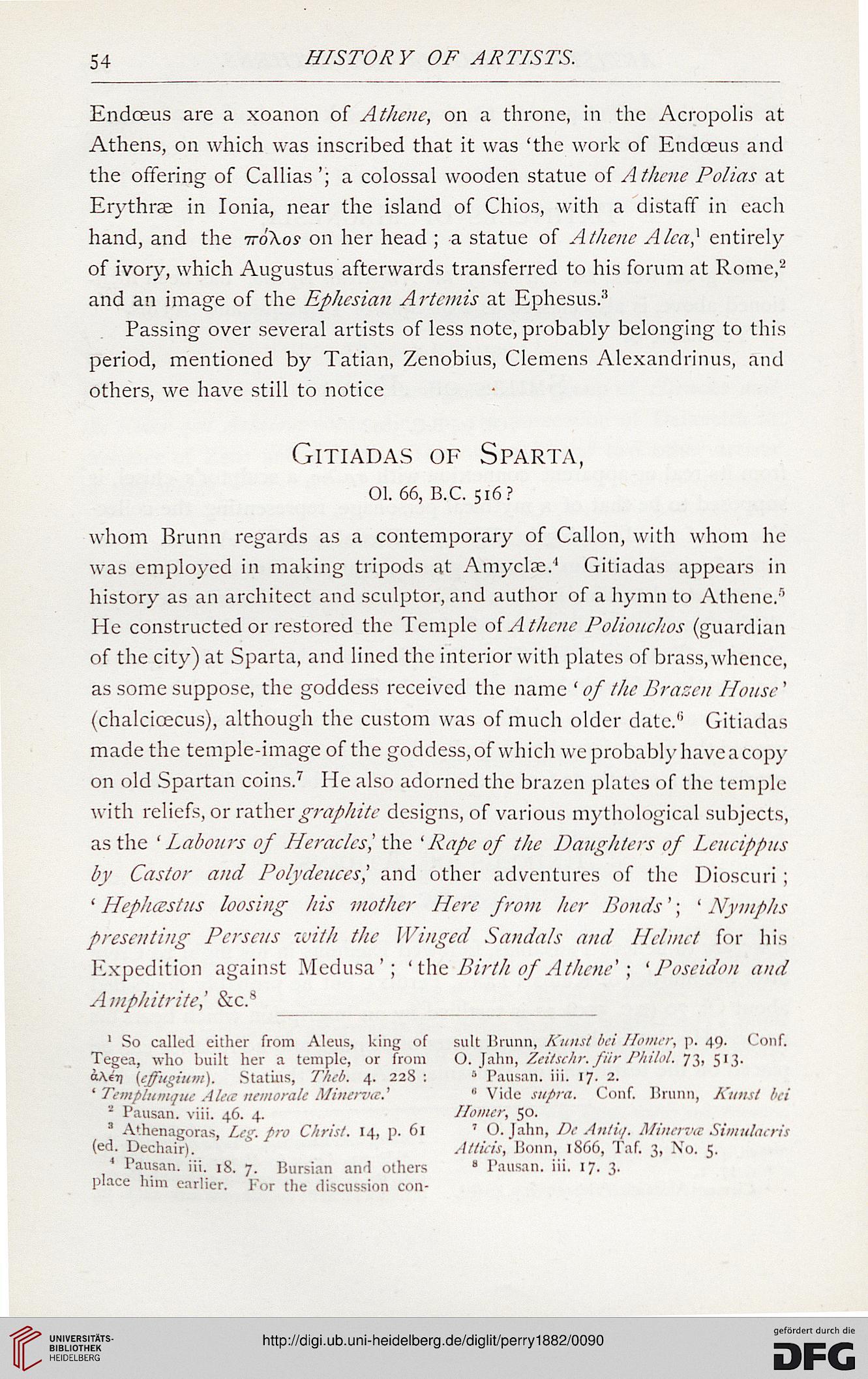54
HISTORY OF ARTISTS.
Endceus are a xoanon of Athene, on a throne, in the Acropolis at
Athens, on which was inscribed that it was 'the work of Endceus and
the offering of Callias '; a colossal wooden statue of Athene Polias at
Erythrae in Ionia, near the island of Chios, with a distaff in each
hand, and the irokos on her head ; a statue of Athene A lea} entirely
of ivory, which Augustus afterwards transferred to his forum at Rome,2
and an image of the Ephesian Artemis at Ephesus.8
Passing over several artists of less note, probably belonging to this
period, mentioned by Tatian, Zenobius, Clemens Alexandrinus, and
others, we have still to notice
Gitiadas of Sparta,
01. 66, B.C. 516?
whom Brunn regards as a contemporary of Callon, with whom he
was employed in making tripods at Amycla:.1 Gitiadas appears in
history as an architect and sculptor, and author of a hymn to Athene/'
He constructed or restored the Temple of Athene Poliouchos (guardian
of the city) at Sparta, and lined the interior with plates of brass, whence,
as some suppose, the goddess received the name ' of the Brazen House'
(chalcicecus), although the custom was of much older date.'1 Gitiadas
made the temple-image of the goddess, of which we probably have a copy
on old Spartan coins.7 He also adorned the brazen plates of the temple
with reliefs, or rather graphite designs, of various mythological subjects,
as the 'Labours of Heracles] the 'Rape of the DaugJiters of Lcucippus
by Castor and Polydeuces,' and other adventures of the Dioscuri ;
' Hephcestns loosing his mother Here from her Bonds'; ' Nymphs
presenting Perseus with the Winged Sandals and Helmet for his
Expedition against Medusa'; ' the Birth of Athene'; 'Poseidon and
Amphitrite,' &c.8
1 So called cither from Aleus, king of suit lirunn, A'unst bet Homer, p. 49. Conf.
Tegea, who built her a temple, or from O. Jahn, Zeitschr. fUr Philol. 73, 513.
oAe'7) (effugium). Statins, Tlieb. 4. 228 : 5 Pausan. iii. 17. 2.
' Temphtmque Ale<c nemorale Minerva:.' " Vide supra. Conf. lirunn, Kunst bci
* Pausan. viii. 46. 4. Homer, 50.
' A'.henagoras, Leg. pro Christ. 14, p. 61 ' O. Jahn, De Antii/. MinervaSimuiacril
(ed. Dechair). Attuis, Uonn, 1866, Taf. 3, No. 5.
4 Pausan. iii. 18. 7. Bursian and others 8 Pausan. iii. 17. 3.
place him earlier. For the discussion con-
HISTORY OF ARTISTS.
Endceus are a xoanon of Athene, on a throne, in the Acropolis at
Athens, on which was inscribed that it was 'the work of Endceus and
the offering of Callias '; a colossal wooden statue of Athene Polias at
Erythrae in Ionia, near the island of Chios, with a distaff in each
hand, and the irokos on her head ; a statue of Athene A lea} entirely
of ivory, which Augustus afterwards transferred to his forum at Rome,2
and an image of the Ephesian Artemis at Ephesus.8
Passing over several artists of less note, probably belonging to this
period, mentioned by Tatian, Zenobius, Clemens Alexandrinus, and
others, we have still to notice
Gitiadas of Sparta,
01. 66, B.C. 516?
whom Brunn regards as a contemporary of Callon, with whom he
was employed in making tripods at Amycla:.1 Gitiadas appears in
history as an architect and sculptor, and author of a hymn to Athene/'
He constructed or restored the Temple of Athene Poliouchos (guardian
of the city) at Sparta, and lined the interior with plates of brass, whence,
as some suppose, the goddess received the name ' of the Brazen House'
(chalcicecus), although the custom was of much older date.'1 Gitiadas
made the temple-image of the goddess, of which we probably have a copy
on old Spartan coins.7 He also adorned the brazen plates of the temple
with reliefs, or rather graphite designs, of various mythological subjects,
as the 'Labours of Heracles] the 'Rape of the DaugJiters of Lcucippus
by Castor and Polydeuces,' and other adventures of the Dioscuri ;
' Hephcestns loosing his mother Here from her Bonds'; ' Nymphs
presenting Perseus with the Winged Sandals and Helmet for his
Expedition against Medusa'; ' the Birth of Athene'; 'Poseidon and
Amphitrite,' &c.8
1 So called cither from Aleus, king of suit lirunn, A'unst bet Homer, p. 49. Conf.
Tegea, who built her a temple, or from O. Jahn, Zeitschr. fUr Philol. 73, 513.
oAe'7) (effugium). Statins, Tlieb. 4. 228 : 5 Pausan. iii. 17. 2.
' Temphtmque Ale<c nemorale Minerva:.' " Vide supra. Conf. lirunn, Kunst bci
* Pausan. viii. 46. 4. Homer, 50.
' A'.henagoras, Leg. pro Christ. 14, p. 61 ' O. Jahn, De Antii/. MinervaSimuiacril
(ed. Dechair). Attuis, Uonn, 1866, Taf. 3, No. 5.
4 Pausan. iii. 18. 7. Bursian and others 8 Pausan. iii. 17. 3.
place him earlier. For the discussion con-




